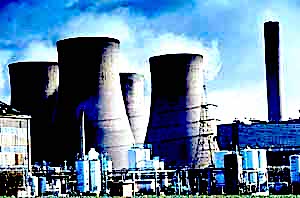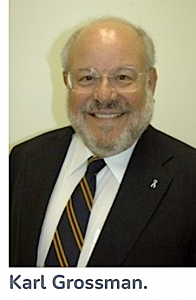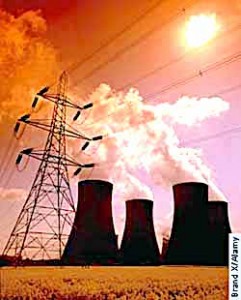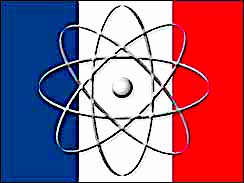Part 1 – Original → HERE
by Karl Grossman
13 March 200
Nuclear advocates in government and the nuclear industry are engaged in a massive,
heavily financed drive to revive atomic power in the United States-with most of the
mainstream media either not questioning or actually assisting in the promotion.
With a very few notable exceptions, such as the Los Angeles Times, the US media have turned the same sort of blind, uncritical eye on the nuclear industry’s claims that led an earlier generation of Americans to believe atomic energy would be “too cheap to meter,” comments Michael Mariotte, executive director of the Nuclear Information and Resource Service. “The nuclear industry’s public relations effort has improved over the past 50 years, while the natural skepticism of reporters toward corporate claims seems to have disappeared.”
The New York Times continues to be, as it was a half-century ago when nuclear technology was first advanced, a media leader in pushing the technology, which collapsed in the US with the 1979 Three Mile Island and 1986 Chernobyl nuclear plant accidents. The Times has showered readers with a variety of pieces advocating a nuclear revival, all marbled with omissions and untruths. A lead editorial headlined “The Greening of Nuclear Power” (5/13/06) opened:
Not so many years ago, nuclear energy was a hobgoblin to environmentalists, who feared the potential for catastrophic accidents and long-term radiation contamination… But this is a new era, dominated by fears of tight energy supplies and global warming. Suddenly nuclear power is looking better.
Nukes Add to Greenhouse
Parroting a central atomic industry theme these days, the Times editors declared, “Nuclear energy can replace fossil-fuel power plants for generating electricity, reducing the carbon dioxide emissions that contribute heavily to global warming.” As a TV commercial frequently aired by the Nuclear Energy Institute (NEI), the nuclear industry trade group, states: “Nuclear power plants don’t emit greenhouses gases, so they protect our environment.”
What is left unmentioned by the NEI, the Times and other mainstream media making this claim is that the overall “nuclear cycle,” which includes uranium mining and milling, enrichment, fuel fabrication and disposal of radioactive waste-has significant greenhouse gas emissions that contribute to global warming.
As Michel Lee, chair of the Council on Intelligent Energy & Conservation Policy, wrote in an (unpublished) letter to the Times, the dirty secret is that nuclear power makes a substantial contribution to global warming. Nuclear power is actually a chain of highly energy-intensive industrial processes. These include uranium mining, conversion, enrichment and fabrication of nuclear fuel; construction and deconstruction of the massive nuclear facility structures; and the disposition of high-level nuclear waste.
She included information on “independent studies that document in detail the extent to which the entire nuclear cycle generates greenhouse emissions.”
Separately, Lee wrote to a Times journalist stating that the “fiction” that nuclear power does not contribute to global warming “has been a prime feature of the nuclear industry’s and Bush administration’s PR campaign” that “unfortunately… has been swallowed by a number of New York Times reporters, op-ed columnists and editors.”
Greens for Gire
In “The Greening of Nuclear Power,” the Times, like other mainstream media touting a nuclear restart, also spoke of environmentalists changing their stance on nuclear power. “Two new leaders” have emerged “to encourage the building of new nuclear reactors,” according to the editorial. They happen to be Christine Todd Whitman, George W. Bush’s first Environmental Protection Agency administrator, and Patrick Moore, “a co-founder of Greenpeace.” The Times heralded this as “the latest sign that nuclear power is getting a more welcome reception from some environmentalists.”
However, “both Whitman and Moore… are being paid to do so by the Nuclear Energy Institute,” noted the Center for Media and Democracy’s Diane Farsetta (PRWatch.org, 3/14/07). In her piece “Moore Spin: Or, How Reporters Learned to Stop Worrying and Love Nuclear Front Groups,” Farsetta also reported:
A Nexis news database search on March 1, 2007 identified 302 news items about nuclear power that cite Moore since April 2006. Only 37 of those pieces-12 percent of the total-mention his financial relationship with NEI.
Whitman and Moore were hired as part of NEI’s “Clean and Safe Energy Coalition” in 2006, which is “fully funded” by the institute, Farsetta noted. As for Moore and Greenpeace, his “association… ended in 1986,” and he “has now spent more time working as a PR consultant to the logging, mining, biotech, nuclear and other industries… than he did as an environmental activist.”
According to Harvey Wasserman, senior advisor to Greenpeace USA and co-author of Killing Our Own: The Disaster of America’s Experience With Atomic Radiation (Brattleboro Reformer, 2/24/07), “Moore sailed on the first Greenpeace campaign, but he did not actually found the organization.” Wasserman went on to cite an actual founder of the organization, Bob Hunter, describing Moore as “the Judas of the ecology movement.”
Scarce High-grade Fuel
Insisting that “there is good reason to give nuclear power a fresh look,” “The Greening of Nuclear Power”
further claimed, “It can diversify our sources of energy with a fuel-uranium-that is both abundant and inexpensive.”
This, too, was bogus. The uranium from which fuel used in nuclear power plants is made-so-called “high-grade” ore containing substantial amounts of fissionable uranium-235-is, in fact, not “abundant.” As Andrew Simms of the New Economics Foundation told BBC News (11/29/05), another “dirty little secret” of nuclear power is that “startlingly, there’s only a few decades left of the proven high-grade uranium ore it needs for fuel.” This has been the projection for years.
Indeed, this limit on “high-grade” uranium ore is why the industry projects that, in the long-term, nuclear power will need to be based on breeder reactors running on manmade plutonium. But use of plutonium-fueled reactors has been stymied because they can explode like atomic bombs-they contain tons of plutonium fuel, while the first bomb using plutonium, dropped on Nagasaki, contained 15 pounds. Because it takes only a few pounds of plutonium to make an atomic bomb, they also constitute an enormous proliferation risk.
Blaming Jane Fonda
“The Jane Fonda Effect” (9/16/07), a Times Magazine column by Stephen Dubner and Steven Levitt, blamed nuclear power’s stall on the 1979 film, The China Syndrome, starring Jane Fonda, which opened days before the Three Mile Island partial meltdown. “Stoked by The China Syndrome,” it caused “widespread panic,” wrote Dubner and Levitt, even though, they maintained, the accident did not “produce any deaths, injuries or significant damage.”
In fact, the utility that owned Three Mile Island has for years been quietly paying people whose family members died, contracted cancer or were otherwise impacted by the accident. While settlements range up to $1 million, the utility company continues to insist this does not acknowledge fault. The toll of Three Mile Island is chronicled in my television documentary Three Mile Island Revisited (EnviroVideo, 1993) and Wasserman’s book Killing Our Own (which includes a devastating chapter, “People Died at Three Mile Island”), among other works.
But Dubner and Levitt continue undeterred, declaring, “The big news is that nuclear power may be making a comeback in the United States.” They acknowledge the Chernobyl accident, stating that it “killed at least a few dozen people directly.” They admit that it “exposed millions more to radiation,” but keep silent about the consequences of this in terms of illness and death. This atomic version of Holocaust denial flies in the face of voluminous research on the disaster that puts the number of dead in the hundreds of thousands.
“At least 500,000 people-perhaps more-have already died out of the 2 million people who were officially classed as victims of Chernobyl in Ukraine,” said Nikolai Omelyanets, deputy head of the National Commission for Radiation Protection in Ukraine (Guardian, 3/25/06). Dr. Alexey Yablokov, president of the Center for Russian Environmental Policy, calculates a death toll of 300,000. In the book Chernobyl: 20 Years On, which he co-edited, Yablokov writes, “In 20 years it has become clear that not tens, hundreds of thousands, but millions of people in the Northern Hemisphere have suffered and will suffer from the Chernobyl catastrophe.”
The New York Times Magazine also published “Atomic Balm?” (7/16/06), by Jon Gertner; the subhead read, “For the first time in decades, increasing the role of nuclear power in the United States may be starting to make political, environmental and even economic sense.” Gertner used the term nuclear “renaissance,” and again forwarded the claim that “the supply [of uranium] is abundant.”
Gertner told of how the “lifespan” for nuclear plants was set at 40 years because this was considered “how long a large nuclear plant could safely operate.” This has “proved a conservative estimate,” he states-without providing a factual basis. So the Nuclear Regulatory Commission has been “granting 20-year extensions” to the 103 US nuclear plants so they “can run for a total of 60 years.” (Consider the safety and reliability of 60-year-old cars speeding down highways.)
“Even with such licensing renewals, though, it’s doubtful the current fleet of plants will run for, say, 80 years,” he continued, and “that means the industry, in a way, is in a race against time.” It needs to build new plants because the “absence” of nuclear power “would probably pose tremendous challenges for the United States.”
The New York Times also allows its nuclear advocacy to slip into its news stories. In an article (11/27/07) about the French nuclear power company Areva signing a deal with a Chinese atomic corporation, Times reporter John Tagliabue wrote of Areva chief executive Anne Lauvergeon’s “long path from dirty hands to clean energy.” The “dirty hands” referred to a youthful interest in archaeology; that nuclear power is “clean energy” appears to require no explanation.
Another story, datelined Fort Collins, Colorado (11/19/07), reported on two energy projects proposed for what the paper calls “a deeply green city.” Describing the plans as “exposing the hard place that communities like this across the country are likely to confront,” Times reporter Kirk Johnson wrote:
Both projects would do exactly what the city proclaims it wants, helping to produce zero-carbon energy. But one involves crowd-pleasing, feel-good solar power, and the other is a uranium mine, which has a base of support here about as big as a pinkie. Environmentalism and local politics have collided with a broader ethical and moral debate about the good of the planet, and whether some places could or should be called upon to sacrifice for their high-minded goals.
Other Revivalists
Other media promoting a nuclear revival-their words prominently featured on NEI’s website-include USA Today (3/5/06): “The facts are straightforward: Nuclear power… creates virtually none of the pollution that causes climate change and delivers electricity cheaper than other forms of generation do.” And the Augusta Chronicle (8/21/06): “Nuclear power-for decades perceived as an environmental scourge-is emerging as the cleanest and most cost-efficient source of energy available, a fact conceded even by environmentalists.” And Investor’s Business Daily (12/1/06): “We can worry about imaginary threats of nuclear energy or the real dangers of fossil fuel pollution.”
Glenn Beck of CNN Headline News also joined the chorus of support (5/2/07): “Look, America should embrace nuclear power, even if it’s [just] to get off the foreign oil bandwagon.” This is also common nuclear disinformation, that nuclear power is needed to displace foreign oil. The only energy produced by nuclear power is electricity-and only 3 percent of electricity in the US is generated with oil.
There are a few exceptions in the mainstream media, notably the other Times, the Los Angeles Times. “The dream that nuclear power would turn atomic fission into a force for good rather than destruction unraveled with the Three Mile Island disaster in 1979 and the Chernobyl meltdown in 1986,” the paper stated (7/23/07) in an editorial headlined: “No to Nukes: It’s Tempting to Turn to Nuclear Plants to Combat Climate Change, but Alternatives Are Safer and Cheaper.”
Those who claim nuclear power “must be part of any solution” to global warming or climate change “make a weak case,” said the L.A. Times, citing:
the enormous cost of building nuclear plants, the reluctance of investors to fund them, community opposition and an endless controversy over what to do with the waste…. What’s more, there are cleaner, cheaper, faster alternatives that come with none of the risks.
Continued in Part 2.
The Hoax of Eco-Friendly Nuclear Energy: Part 2
by Karl Grossman
March 13, 2008
As to the risks, the mainstream media’s handling-or non-handling-of the US government’s most comprehensive study on the consequences of a nuclear plant accident is instructive. Calculation of Reactor Accident Consequences 2 (known as CRAC-2) was done by the Nuclear Regulatory Commission in the 1980s. Bill Smirnow, an anti-nuclear activist, has tried for years to interest media in reporting on it-sending out information about it continually.
The study estimates the impacts from a meltdown at each nuclear plant in the US in categories of “peak early fatalities,” “peak early injuries,” “peak cancer deaths” and “costs [in] billions.” (“Peak” refers to the highest calculated value-not a “worst case scenario,” as worse assumptions could have been chosen.) For the Indian Point 3 plant north of New York City, for example, the projection is that a meltdown would cause 50,000 “peak early fatalities,” 141,000 “peak early injuries,” 13,000 “peak cancer deaths,” and $314 billion in property damage-and that’s based on the dollar’s value in 1980, so the cost today would be nearly $1 trillion.
For the Salem 2 nuclear plant in New Jersey, the study projects 100,000 “peak early fatalities,” 70,000 “peak early injuries,” 40,000 “peak cancer deaths,” and $155 billion in property damage. The study provides similarly staggering numbers across the country.
“I’ve sent the CRAC-2 material out for years to media and have never heard a thing,” Smirnow told Extra!:
Not anyone in the media ever even asked me a question. There’s no excuse for this media inattention to such an important subject, and it shows how they’re falling flat on their faces in not performing their purported mission of educating and informing the public. Whatever their reason or reasons for not informing their readers and listeners, the effect is one of helping the nuclear power industry and hurting the public. If the public was informed, this new big pro-nuke push would never happen.
Also in the way of sins of omission is the media silence on “routine emissions”-the amount of radioactivity the US government allows to be routinely released by nuclear plants. “It doesn’t take an accident for a nuclear power plant to release radioactivity into our air, water and soil,” says Kay Drey of Beyond Nuclear at the Nuclear Policy Research Institute. “All it takes is the plant’s everyday routine operation, and federal regulations permit these radioactive releases. Rarely, if ever, is this reported by media.” The radioactive substances regularly emitted include tritium, krypton and xenon. The Nuclear Regulatory Commission sets a “permissible” level for these “routine emissions,” but, as Drey states, “permissible does not mean safe.”
Hidden Subsidies
Another lonely voice amid the media nuclear cheerleaders is the Las Vegas Sun, which recently has been especially outraged by $50 billion in loan guarantees for the nuclear industry to build new nuclear plants included in the 2007 Energy Bill. The Sundemanded (8/1/07): “Pull the Plug Already.”
In reporting on the economics of nuclear power, mainstream media virtually never mention the many government subsidies for it, while continuing to claim that it’s “cost-effective” (Augusta Chronicle, 8/21/06). One such giveaway is the Price-Anderson Act, which shields the nuclear industry from liability for catastrophic accidents. Price-Anderson, supposed to be temporary when first enacted in 1957, has been extended repeatedly and now limits liability in the event of an accident to $10 billion, despite CRAC-2’s projections of consequences far worse than that.
Writing on CommonDreams.org (9/11/07), Ralph Nader explored the economic issue. “Taxpayers alert!” he declared:
The atomic power corporations are beating on the doors in Washington to make you guarantee their financing for more giant nuclear plants. They are pouring money and applying political muscle to Congress for up to $50 billion in loan guarantees to persuade an uninterested Wall Street that Uncle Sam will pay for any defaults on industry construction loans…. The atomic power industry does not give up. Not as long as Uncle Sam can be dragooned to be its subsidizing, immunizing partner. Ever since the first of 100 plants opened in 1957, corporate socialism has fed this insatiable atomic goliath with many types of subsidies.
Ignored Alternatives
|
|
“Vive les Nukes,” a pro-nuclear segment broadcast on 60 Minutes in 2007, was rife with errors and omissions. Image credit: 60 Minutes |









Leave a Reply
Want to join the discussion?Feel free to contribute!